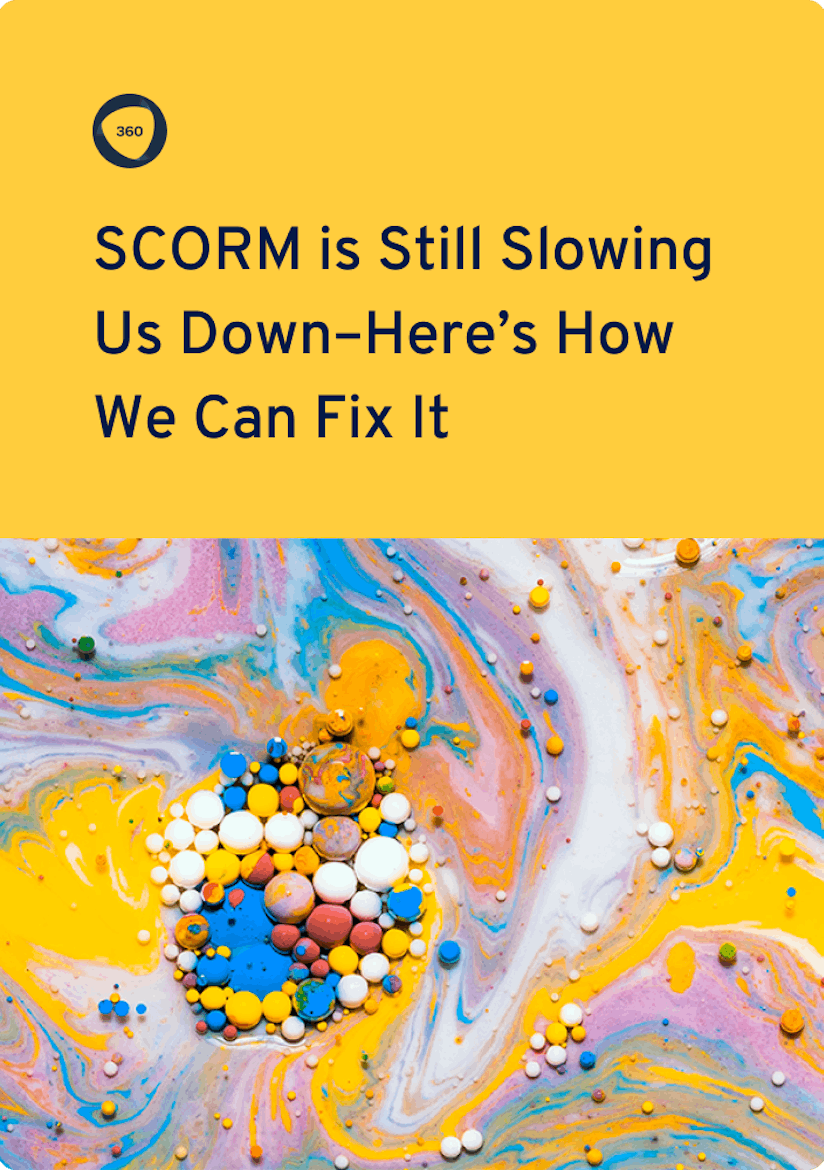
Discover the learning platform powered by collaborative learning.
A 15-minute discussion with an expert
100% tailored to your needs - with ❤️
No commitment. Free as can be.

If you’ve worked in learning and development for more than a minute, you’ve heard of SCORM. Maybe your LMS runs on it. Maybe you’ve inherited hundreds of SCORM files you can’t easily edit. And maybe, just maybe, you’ve wondered if there’s a better way.
The truth is: while SCORM may feel like a relic from another era, it’s still very much part of the learning landscape in 2026. The good news? You can make it work better than ever for you—with the right tools, mindset, and strategy.
Here’s your 2026 guide to understanding SCORM, its limitations, and how to get real business value from it—without getting stuck in the past.
3 key takeaways

By providing your contact info, you agree to receive communications from 360Learning. You can opt-out at any time. For details, refer to our Privacy Policy.
SCORM stands for Sharable Content Object Reference Model. It’s a set of technical standards used to create and share online training materials.
In simple terms, SCORM acts like a universal translator. It allows eLearning content built in one system to be launched, tracked, and reported on in another. That’s why so many organizations have used it for decades—to host off-the-shelf courses or develop custom programs that play nicely with their learning management system (LMS).
Back in the late 1990s, this was revolutionary. The internet was starting to connect organizations and learners across the globe, and the idea of digital learning was taking shape. Flash-based animations made online learning interactive and exciting—if you remember those “click here to continue” buttons, you know the vibe.
But there was one big problem: every course was built differently, using different systems. Nothing was interoperable. The creation of SCORM in the early 2000s changed that. For the first time, learning teams could create content that worked everywhere.
Even though Flash has since disappeared and HTML5 rules the web, SCORM still carries much of that early DNA. Many SCORM-based courses still look and feel like early-2000s software because updating them all would be too expensive.
SCORM hasn’t been static since its introduction. In fact, there are two main versions in wide circulation today: SCORM 1.2 and SCORM 2004.
SCORM 1.2 offers basic tracking capabilities, but with some notable limitations:
SCORM 2004 introduced several major improvements:
While SCORM 2004 is technically more powerful, SCORM 1.2 still dominates the eLearning world because it’s simple, stable, and compatible with almost every LMS. SCORM 2004 is less widely supported and therefore less common.
But here’s the real problem: both versions share the same fundamental limitations. They can’t track learning that happens outside the LMS, like mobile, social, or experiential learning. They don’t measure collaboration or performance outcomes.
And they keep your content trapped in static packages that are hard to update or improve. Let’s explore these ideas further.
Even though SCORM revolutionized eLearning in its earlier days, it wasn’t designed for the modern L&D world. Here’s where it falls short of expectations today:
Building a SCORM course is often a long, technical process. Instructional designers need specialized authoring tools just to make this manageable.
And if a compliance rule changes or a visual asset needs replacing, you have to update the original source file, repackage it, and re-upload the course. What’s worse, you often lose learner progress data in the process.
So what in theory should be a quick update—fixing a policy reference or refreshing a slide—can take hours or even days. This rigidity discourages iteration, which makes it harder for L&D teams to keep content fresh and accurate.
Traditional SCORM workflows are designed for small, specialist teams. Instructional designers build the content, while managers and L&D coordinators provide feedback via long review cycles.
There’s rarely an easy way for subject-matter experts to contribute directly to content updates in SCORM. This creates bottlenecks, slows down delivery, and often means valuable knowledge from across the organization never makes it into training materials.
SCORM courses can feel decidedly static and outdated compared to modern digital experiences. Most follow a linear “click-next” structure, with limited interactivity and few opportunities for user collaboration or reflection.
Learners now expect the same fluid, social, mobile-first experiences they get from apps and online platforms. But SCORM struggles to deliver that kind of engagement.
From uploading and testing files to ensuring version compatibility, managing SCORM content can be a logistical burden. Not every LMS handles SCORM packages the same way, so something that works perfectly in one system might break in another.
They’re also not built well to manage data and deliver insights. You can lose a lot of crucial information as users switch between tools.
For large organizations juggling hundreds of SCORM courses, maintenance quickly becomes a full-time job.
Even if SCORM isn’t your favorite format, it’s probably still part of your learning ecosystem. The key is to make it work for you, while setting your L&D strategy up for the future.
Don’t let SCORM dictate how you design learning experiences. Start with the outcomes your organization cares about: improving sales performance, reducing onboarding time, increasing compliance certifications, or developing leadership skills.
From there, decide which learning formats make the most sense. Some modules might still live as SCORM courses, but others could be microlearning videos, discussion-based challenges, or peer-led sessions.
When learning is designed around business goals—not technical constraints—it’s more likely to deliver measurable impact.
Don’t let SCORM dictate how you design learning experiences. Start with the outcomes your organization cares about: improving sales performance, reducing onboarding time, increasing compliance certifications, or developing leadership skills.
A modern LXP updates your legacy SCORM content with more dynamic collaborative learning tools and features. Platforms like 360Learning let you import and deliver SCORM courses alongside interactive, community-driven content.
Keep your existing content library while layering on comments, reactions, and discussions that bring static content to life. Instead of replacing everything at once, you can blend traditional courses with peer learning experiences, achieving the best of both worlds.
SCORM’s biggest drawback is arguably how hard it makes it to build new courses. Meanwhile, AI is completely transforming how L&D teams create and maintain content.
With AI-powered authoring tools, you can build new micro-courses, quizzes, or refresher modules in minutes, instead of weeks. If you identify a skills gap that your current SCORM library doesn’t address, you can generate targeted learning content on demand, with no need for a dedicated instructional designer.
Most importantly, anyone can do this, including subject-matter experts and volunteers from around your organization.
This keeps your learning programs agile and responsive, even while you maintain older SCORM assets for compliance or foundational training.
Collaboration makes learning stick. And it’s something SCORM can’t do on its own. By giving your subject-matter experts the tools to co-create and share their expertise, you can empower team members to become valuable, active contributors to organizational upskilling.
In 360Learning, for instance, SMEs can author mini-courses, respond to learner questions, and continuously improve content based on feedback.
This approach supplements static SCORM courses and transforms your learning culture into something dynamic, social, and scalable.
SCORM is a way to deliver and track learning. But it’s not a learning strategy in itself. Use it where it makes sense, like standardized compliance training. But also look beyond it for skills development and experiential learning.
Complement SCORM-based modules with mentoring programs, community discussions, and real-world practice. Plus, of course, the LXP, AI authoring, and additional tools mentioned above. Think of SCORM as one tool in your toolbox, not the whole kit.
As mentioned above, 360Learning lets you move beyond SCORM’s limitations without losing the value and history of your existing content. Our collaborative learning platform lets you:
“Our old system couldn’t handle our versioning codes, so we relied on inefficient workarounds. With 360Learning, we can finally align content with our document control references. It’s been such an improvement that we’re now expanding versioning to other training materials.”
- Nick Taylor, Head of L&D EMEA at Ishida
It’s a modern upgrade to make the difficult task of maintaining SCORM courses less painful. Every learning experience becomes more interactive and collaborative, so your teams don’t just complete courses; they connect, discuss, and learn together.
SCORM seems to be here to stay. But that doesn’t mean your learning strategy has to stay stuck with it. By pairing your existing SCORM library with modern, collaborative tools, you breathe new life into your learning ecosystem.
With 360Learning, you can keep what works, improve what doesn’t, and finally move from simply tracking learning to truly driving performance.
Ready to get started? Learn how 360Learning helps you modernize your SCORM-based learning today.
A 15-minute discussion with an expert
100% tailored to your needs - with ❤️
No commitment. Free as can be.
By providing your contact info, you agree to receive communications from 360Learning. You can opt-out at any time. For details, refer to our Privacy Policy.
What is a SCORM file?
What are the different SCORM versions?
Is SCORM still relevant in 2026?
What’s the best alternative to SCORM?